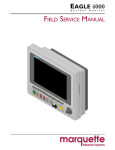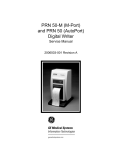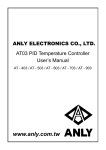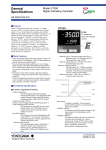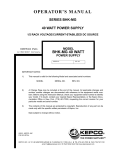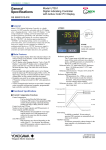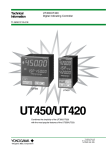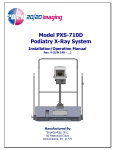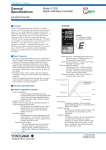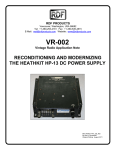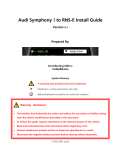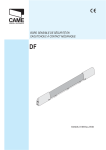Download Program Controller X
Transcript
Instruction Manual Program Controller X Type : PVX INP–TN1PVXd-E PREFACE We thank you for purchasing Fuji Program Controller X (Type: PVX). This instruction manual explains the installation, wiring, operation and maintenance of the Program Controller X, so please read through it before using the controller. ■ Safety Precautions Before use, carefully read the safety precautions for correct operation. • The precautions concern important matters related to safety. Be sure to observe them. The safety matters are ranked to “DANGER,” “CAUTION.” Indications and meanings are as follows. DANGER If the handling is wrong, dangerous situations might occur, caus- CAUTION If the handling is wrong, dangerous situations might occur, causing medium or slight degree of injury or physical damage only. ing death or serious injury. DANGER • If the fault or anomaly of the device may cause serious accident or troubles to other devices, externally install appropriate protective circuit to avoid accidents. • The instrument has no power switch nor fuse. Install them if necessary. (Fuse rating 250 V, 1 A). • For avoiding device breakage and fault, supply a power voltage matching the rating. • For avoiding electric shock, malfunction and device troubles, do not turn on power until all installation and wiring have ended. • The instrument is not an intrinsically-safe explosion-proof type. Do not use it in atmosphere of combustible or explosive gases. • Never disassemble, retouch, remodel nor repair the instrument. Otherwise, abnormal operation, electric shock or fire may occur. • While turned on, do not touch the terminals. Otherwise, electric shock or malfunction may occur. • Before engaging or disengaging the module or unit, turn off power. Otherwise, electric shock, malfunction or troubles may occur. • Periodic maintenance is recommended so that the instrument can be used continuously and safely. Some parts installed on the device have limited service life or are subjected to secular change. • Do not block the ventilation opening located on the top and bottom of the main unit. Otherwise, fault, abnormal operation, shortened service life or fire may occur. –i– INP–TN1PVX-E 1. Handling precaution Read the item “5. Installation and wiring” in this instruction manual and follow the instructions. (1) Do not use the controller in a place with high temperature, CAUTION high humidity, dust, corrosive gas, vibration, shock, etc., to prevent electric shocks, fire or malfunction. (2) Note that improper installation will cause drop-off, trouble, or malfunction. (3) Keep the unit from foreign objects such as power cables chips to prevent fire accident, trouble malfunction. 2. Wiring precaution Read the item “5. Installation and wiring” in this instruction manual and follow the instructions. CAUTION (1) The unit must be earthed. If not earthed, it causes electric shocks or malfunction. (2) Be sure to connect the rated power source. Connection of different rating of power source may lead to a risk of fire accident. (3) Wiring work must be performed by qualified engineers. Incorrect wiring may lead to electric shocks, malfunction or trouble. 3. Operation precaution CAUTION Do not touch the terminals when power is ON to avoid electric shocks or malfunction. 4. Parameters (1) Read the items “2. Programming”, “3. Setting up” and “4. CAUTION INP–TN1PVX-E Advanced Usage” in this instruction manual and follow the instructions. (2) Use each parameter within the limit of operation noted in this instruction manual. – ii – ■ Code Symbols 1 2 3 P V X 4 5 6 7 8 9 1 10 11 12 13 Y Contents Control output Relay contact output SSR/SSC drive output DC4 to 20mA output 1 2 3 Digital input External command input (4 points) Pattern select input (4 points) External command input + Pattern select input Time signal output 1 to 4 C P D T Provided Status output (Operating profile output) Provided S Modification No. 1 Extended digital output (Open collector output: 2 points) Y T A Not provided To be used as time signal (TS5, 6) To be used as alarm (ALM3, 4) Auxiliary signal output Note) Not provided 1 to 5 VDC at Voltage output: the shipment 1 point from factory Voltage output: 2 points 0 1 2 Communication facility Not provided Y • Scope of supply Program controller, panel fixtures, and user’s manual User’s manual, instructions and setting E J English version Japanese version ■ List of Abbreviations frequently used in this Manual: CLR: DSP: PTN: SEL: ENT: HLD: Clear Display Pattern Select Enter Hold SFT: REST: ALM: MAN: PTN: PV: Shift Reset Alarm Manual Pattern Processing Variable – iii – DV: SV: TM: MV: A/M: Deviation Set Value Time Manipulating Value Auto/Manual INP–TN1PVX-E CONTENTS PREFACE ................................................................................................................ i Caution on Safety .................................................................................................................... Code Symbols ......................................................................................................................... List of Abbreviations frequently used in this Manual: ............................................................ Overview ................................................................................................................................. Explanation of Front Panel ...................................................................................................... Explanation of Keys and How to Use Them ........................................................................... i iii iii vi vii vii SECTION 1 1. 2. 3. BEFORE STARTING OPERATION .................................................... 1-1 Changing Displays on Operating Screen ......................................................................... Operation .......................................................................................................................... Parameter Setting Overview ............................................................................................ 1-1 1-1 1-3 SECTION 2 1. 2. 3. PROGRAMMING.................................................................................. 2-1 Parameter Structure and Parameter Calling Method ........................................................ Program Pattern Setting (Program Pattern Setting Channel) ........................................... 2-1 2-2 2.1 Program pattern structure .......................................................................................................................... 2.2 Pattern Setting [Setting of a set value (SV) and time] .............................................................................. 2.3 Setting of supplementary functions ........................................................................................................... 2.3.1 Setting of PID group ......................................................................................................................... 2.3.2 Setting of alarm values 1 to 4 ........................................................................................................... 2.3.3 Setting of time signal ........................................................................................................................ 2.3.4 Guarantee soak (Waiting for PV to follow) ..................................................................................... 2.3.5 PV Start (Allowing the program to start from the current PV) ........................................................ 2.3.6 Cyclic Operation (Repetitious execution of a pattern) ..................................................................... 2.3.7 Pattern-Link Operation (Successive pattern execution) ................................................................... 2.4 Editing Program Pattern ............................................................................................................................ 2.4.1 Segment insertion (a new segment is created between segments) ................................................... 2.4.2 Segment erasure (a segment in a pattern is erased) .......................................................................... 2.4.3 Copying a pattern ............................................................................................................................. 2.4.4 Pattern erasure .................................................................................................................................. 2.4.5 Erasure of all patterns ....................................................................................................................... 2.4.6 Change of running program ............................................................................................................. 2-2 2-4 2-6 2-6 2-7 2-8 2-9 2-10 2-11 2-12 2-13 2-13 2-14 2-15 2-16 2-16 2-17 Setting of PID Group (PID Setting Channel) ................................................................... 2-18 3.1 Structure of PID Setting Channel .............................................................................................................. 3.2 Setting of each parameter .......................................................................................................................... 3.2.1 Setting of proportional band (P), integration time (I), and differentiation time (D) ........................ 3.2.2 Setting of dead zone ......................................................................................................................... 3.2.3 Manipulating value (MV) upper and lower limits ............................................................................ 3.2.4 Reversing specification .................................................................................................................... 3.2.5 Non-linear gain ................................................................................................................................. 3.2.6 Integration break point ..................................................................................................................... 3.2.7 Manual reset ..................................................................................................................................... 2-18 2-19 2-21 2-21 2-22 2-22 2-23 2-23 2-24 SECTION 3 1. 2. SETTING UP .. Start-up and specification changes .............................. 3-1 Structure of System Setup Channel ................................................................................. Setting of Each Parameter ................................................................................................ 3-1 3-3 2.1 2.2 2.3 2.4 2.5 2.6 Setting of PV input type and input range .................................................................................................. Setting of PV display unit (°C or°F) and 0.1°C (°F) notation (for thermocouple or resistance bulb) ....................................................................................................... Setting of full scale and base scale in the engineering unit notation (for DC voltage and current input) ............................................................................................................ PV filter (reducing the wander of PV arising from noise) ........................................................................ PV shift (shifting zero point of PV) .......................................................................................................... Start mode (defining a startup mode at resumption of power supply) ...................................................... INP–TN1PVX-E – iv – 3-3 3-4 3-5 3-6 3-6 3-7 2.7 2.8 2.9 2.10 2.11 2.12 2.13 2.14 2.15 2.16 2.17 3. MV proportional period (for relay-drive or SSR/SSC-drive output) ........................................................ Setting of preset MV (defining MV in the reset state) .............................................................................. Burnout MV setting (defining MV at the burnout) ................................................................................... Setting of alarm type ................................................................................................................................. AO output type (sending PV, SV, and MV to auxiliary analog output) ................................................... AO range and scale (scaling auxiliary analog output) .............................................................................. Time unit (switching from hr:min to min:sec or vice versa) ..................................................................... Setting of time display type (switching from remaining time to lapsed time or vice versa) ..................... END signal output time ............................................................................................................................. Guarantee soak waiting allowance and setting of max. wait time ............................................................ Setting of T-link station number ............................................................................................................... 3-7 3-8 3-8 3-9 3-10 3-11 3-11 3-12 3-12 3-13 3-13 Various Operating Methods ............................................................................................. 3-14 3.1 3.2 3.3 3.4 3.5 In this unit the operation mode (operating profile) can be changed over as illustrated below .................. Auto tuning ................................................................................................................................................ Fixed value operation ................................................................................................................................ Manual operation ....................................................................................................................................... Remote operation (Option) (for the entry of external commands and selected pattern and the output of status) ................................. SECTION 4 1. 2. 4-1 Structure of expert parameter channel ............................................................................. Setting of each parameter ................................................................................................. 4-1 4-2 2.6 2.7 Set value (SV) upper and lower limits ...................................................................................................... Manipulating value (MV) variation limit .................................................................................................. Setting of alarm 1 to 4 hysteresis allowances ............................................................................................ DV differentiate specification D operation of PID is differentiated for DV. ............................................ AT SV mode Auto tuning in the low PV type ................................................................................................................. AT PID mode Obtaining PI control parameter ................................................................................................................. Transmission write protect The SV change via transmission is inhibited. ........................................................................................... SECTION 5 4-4 4-4 4-5 5-1 Outline Diagrams ............................................................................................................. Installation ........................................................................................................................ 5-1 5-1 Appropriate locations for installation ........................................................................................................ How to install the unit ............................................................................................................................... 5-1 5-2 Wiring .............................................................................................................................. 5-2 3.1 3.2 3.3 3.4 3.5 Cautions for wiring .................................................................................................................................... Noise control measures ............................................................................................................................. For connection of load circuit ................................................................................................................... Wiring for the input 1 to 5 VDC ............................................................................................................... External wiring diagram ............................................................................................................................ SECTION 6 1. 2. 3. 4-2 4-2 4-3 4-3 INSTALLATION AND WIRING ......................................................... 2.1 2.2 3. 3-17 ADVANCED USAGE ........................................................................... 2.1 2.2 2.3 2.4 2.5 1. 2. 3-14 3-15 3-16 3-17 5-2 5-2 5-3 5-3 5-3 APPENDIX ............................................................................................ 6-1 Specifications ................................................................................................................... [Program Pattern Preparation Form] ................................................................................ Parameter List .................................................................................................................. 6-1 6-3 6-4 –v– INP–TN1PVX-E ■ Overview This Program Controller, 96 mm × 96 mm in the front-view size, incorporates a microprocessor to perform the programmed control for Processing variables, such as temperature, humidity, pressure, flow rate, rotating speed. Also, transmission with the host system is enabled with the use of T-link configuration. DI Reset External command Run input Hold Advance 23 Pattern select input 22 21 20 9 patterns Program setting 20 segment Fixed SV Fixed (FIX) Sensor input Full multi-input Reset Run/Hold End 3 points •External command input •Pattern select input •Status output Run/Hold Status output End 9 sets Control parameter Program Such as PID SV AI Filter PV •Guarantee soak function •PV start function •Pattern concatenate function •Pattern repeat function (99 times max.) Communication facility PID with autotuning Auto MV Control output Man Manual operation AO •Auxiliary analog output 1/2 points (PV/SV/MV) (Option) •Time signal output 4 points (+2 points) See Note. •Alarm output 2 points (+2 points) See Note. Power supply 100 to 240 VAC INP–TN1PVX-E Reset – vi – DO Note: (+2 points) denotes that either time signal or alarm output may be supplemented as an option. ■ Explanation of Front Panel RUN HLD END MAN ALM TS Lights while the program operation is running PROFILE Lights while the program operation is being held Lights when the program operation is ended Lights when manual control mode is applied PTN C Lights while the control output is ON PV DV Lights when an event occurs due to time signal SV Lights when an alarm is generated SEG TM MV Program number display Segment number display CLR FIX DSP PTN SFT REST A/M SEL AT INS RUN ADV HLD COPY ENT Process variable display (Deviation display while LED indicator is lighted) Set value display or parameter name display Time display. Manipulating value display or parameter set value display when LED indicator is lighted. Lights when upper key Program set key is selected (See the description below) ■ Explanation of Keys and How to Use Them Keys are provided in two lines: the upper line and lower line. To use a function in the lower line, depress an appropriate key as it is. To use a function in the upper line, depress SFT key once and a key to be used. CLR DSP : To be used for changing the display. FIX PTN : To be used for selecting a program pattern. A/M SEL : To be used for selecting a parameter. AT INS : To be used for inserting a program pattern. END ENT : To be used for data setting and entry. RUN HLD REST ADV : Cursor keys to be used for selecting a parameter and for changing a data value. : Cursor keys to be used for selecting a parameter and for selecting a column. SFT : To be depressed when a key function in the upper line is used. When this key is depressed, the LED embedded in this key will light by toggle action, thus indicating that a key in the upper line has been selected. By depressing the key once again, the LED will go off, indicating that a key function in the lower line has been selected. SFT CLR DSP : To be used for erasing a program pattern. SFT FIX PTN : To be used when entering the fixed-value operating mode. SFT A/M SEL SFT AT INS SFT : To be used when switching from AUTO to MANUAL, or vice versa. The AUTO mode and the MANUAL mode are alternately changed over by depressing the key with a toggle mechanism. : To be used when starting the auto tuning. COPY ENT : To be used when copying a program pattern. – vii – INP–TN1PVX-E SECTION 1 BEFORE STARTING OPERATION 1. Changing Displays on Operating Screen Various operation displays can be changed by depressing DSP key. Deviation RUN HLD END MAN ALM TS DV C DSP PV DV SV SV TM MV LOADER CLR DSP SFT FIX PTN A/M SEL REST RUN ADV HLD COPY ENT INS TM PV PV DSP SV Manipulating value MV No. of cycles DSP SFT DSP DSP Alarm 1 to 2 status DSP Time signal status Time signal status DSP 2. Operation (1) Starting the operation Set value RUN SFT Time Operation starts from segment 1. RUN (Reset state) (Running state) (2) Starting the operation at the current temperature (PV start function) Set value RUN SFT RUN Present value Time Operation starts at the present temperature. (Reset state) (Running state) This operation is performed only when YES has been assigned to PV Start (PVST) in the program pattern mode. If NO is assigned in the setting, the normal operation (1) is performed. 1-1 INP–TN1PVX-E (3) Suspending the operation RUN HLD SFT This is an instance when the program running operation is temporarily held while operating the unit. HLD (Running state) (Holding state) To resume the program running operation, follow the step for (1) Starting the operation. (4) Ending the operation RUN SFT Resetting is performed in the running state or in the holding state. (5) Advancing a segment while in the running operation Rest (Running or Holding state) (Reset state) A next segment is forcedly advanced while in the running operation. One segment is advanced for operation. Set value RUN RUN SFT Present position INP–TN1PVX-E Time (Running state) 1-2 Adv (Running state) 3. Parameter Setting Overview The unit parameter structure and parameter calling methods are shown below. End user 0 User level Set maker 1 Expert 2 Keep on pressing for 3 seconds. Setting lock Operating status display SEL Program pattern set channel SEL Parameter for setting a program pattern (see section 2) SEL Parameter for setting a PID group (see section 2) PID channel SEL Parameter to be set for operation (see section 3) SEL Parameter to be set for more advanced use (see section 4) System setup channel Expert channel For details of paramters in each channel, see the Parameter List at the end of this Manual. User level Parameter display range may be changed by setting the user level. 0: End user 1: Set maker 2: Expert Displays parameters in the unshadowed area . The displayed parameters are needed for program pattern setting. Displays parameters in the unshadowed area plus darkshadowed area . The displayed parameters are needed for setting up the unit. Displays parameters in the light-shadowed area in addition to the unshadowed and dark-shadowed areas . The displayed parameters are needed for more advanced use of this unit. 1-3 INP–TN1PVX-E Setting lock This is a setting lock parameter for prevention of an erroneous setting. 0: Total release 1: Operation release 2: Total lock Enables the setting of all parameters, with no setting locked. With the setting locked, no change can be made for parameter values. Permits only the running operation and reset operation. All the setting operations are locked. Inhibits a change in parameter value and the running operation. (However, parameter call and display are allowed) Data change and registration procedures Call a parameter Enter data setting mode Change data Entry INP–TN1PVX-E Depress ENT key. , , : for scrolling data up and down : for for changing a column Depress ENT key. 1-4 Blinks SECTION 2 PROGRAMMING Programmers are requested to read this section carefully. 1. Parameter Structure and Parameter Calling Method With this unit, nine 20-segment program patterns can be registered. Control parameters, such as PID to be used in each segment, can be specified out of nine PID groups as illustrated below. A program pattern is set with the program pattern setting channel, while a PID group is set with the PID setting channel. Channel menu screen User level ( ) User level PTN PTN Setting lock Operation profile ( ) DSP Program pattern Pattern 9 Pattern 2 Segment 1 Segment 20 SV Pattern 1 TM PID No. Setting channel ( PID set channel ( ) SEL ) SEL No. 1 No. 2 No. 9 P I D MAN Key operation on the channel menu screen : Moves up and down in the channel menu. SEL : Selects a channel on display. Key operation on the program pattern setting channel : Various parameters are moved up and down within one segment. : A segment is moved up and down within one pattern. PTN : Patterns (1 to 9) are moved. SEL : Returns to the channel menu. Key operation on PID setting channel : Various parameters are moved up and down within one PID group. : PID groups (1 to 9) are moved right and left. SEL : Returns to the channel menu. 2-1 INP–TN1PVX-E 2. Program Pattern Setting (Program Pattern Setting Channel) 2.1 Program pattern structure SV °C 100 50 0 ALM1 ON time T10N T10F OFF time Time (hr:min) [Programming map] Segment 1 Display Pattern Set value Set value Time Time Setting range Notation Engineering 0 to 10000 unit hr:min or 0:00 to 99:59 min:sec PID No. 1 to 9 Number Alarm 1 set value 0 to 10000 Alarm display Alarm 4 set value Time signal 1 ON time Time signal 1 OFF time hr:min or 0:00 to 99:59 min:sec 0:00 to 99:59 hr:min or min:sec Time signal 6 ON time Time signal 6 OFF time Guarantee soak Yes/No Guarantee soak type YES/NO 0:Up and down 1:Down 2:Up YES/NO PV start Number of cyclic operations 0 to 99 OFF or 1 to 99 1 to 9 OFF or 1 to 9 Link pattern No. INP–TN1PVX-E 2-2 2 3 The programming for this unit can be accomplished by setting parameters necessary for each of segments. For each segment setting, the pattern setting (Setting of set value and time) and other supplementary functional setting (such as PID number, alarms, and time signal) are required. Program setting Supplementary function setting (PID No., alarm, time signal, and so on) Pattern setting (Set value and time setting) 1) Pattern setting • The pattern setting includes the setting of a set value and time for each segment. • Segment “n” would be a segment to which the process will flow from the set value for segment “n-1” to the set value for segment “n” at the time set for segment “n.” In the case of soak segment In the case of ramp segment Set value for segment n Segment n Set value for segment n–1 Set value for segment n–1 Time setting for segment n Example 1) Set value for segment n Time setting for segment n In the event of segment 2 (n=2) on the programming map (Pages 2-2): A pattern in which the process will flow from 25°C (set value for segment 1) to 50°C (set value for segment 2) in 3:00 hours(time setting for segment 2). This is called “ramp segment.” Example 2) In the event of segment 3 (n=3) on the programming map (Pages 2-2): A pattern in which the process will flow from 50 °C (set value for segment 2) to 50 °C (set value for segment 3) in 2:00 hours(time setting for segment 3).This is called “soak segment.” • The first segment will always be a soak segment, because of no set value for segment “n-1.” Example 3) 2) For segment 1 on the programming map (pages 2-2), the process will be soaked for 1:00 hour (time setting for segment 1) at a temperature of 25 °C (set value for segment 1). Setting for other supplementary functions The setting of some supplementary functions is made for each segment, while the setting of others is made only for one in a pattern. Parameters to be set for each segment • • • • Setting of PID group number Setting of alarms 1 to 2 (or 1 to 4) Setting of time signals 1 to 4 (or 1 to 6) Setting of guarantee soak Parameter to be set only for one in a pattern • • • PV start specification Cycle setting Setting of pattern link For particulars of each setting, see an appropriate section for each parameter. 2-3 INP–TN1PVX-E 2.2 Pattern Setting ........... [Setting of a set value (SV) and time] Segments 1 through 3 are registered according to the examples of program patterns. Step Applicable key(s) Invoking a parameter ENT Changing data (set value) Operation profile Explanation Program setting channel menu is invoked. See “1. Parameter structure and Parameter calling method.” SEL SEL Entering the setting mode (set value) Display Pattern Segment Enters the program setting channel. Pattern and segment displays will blink. Enters the set value mode and the set value will blink. Set value Time By using , , data is changed to Set value Time , and . keys, the : For decrement and increment of data : For selecting columns Set value Time Entering the data entry set mode (time) ENT Changing data (time) Entering data (time) INP–TN1PVX-E The data is changed to Set value Time ENT Invoking parameter (segment change) Entering the set value mode The set value blinking will terminate and the data “ ” is entered. Concurrently, the time setting will blink, entering into the time setting mode. Set value Time ENT The time setting blinking will terminate and the data “ ” is entered. Set value Time Pattern . Segment Segment Set value Time 2-4 is invoked. Step Applicable key(s) Changing data Entering the data entry time setting mode Set value Time ENT Changing data (time) Entering data (time) ENT Changing data Entering the data entry time setting mode ” The time is changed to “ .” Segment Segment ENT The set value is changed to “ ” Set value Time Set value Time ENT is invoked. Set value Time Set value Time Changing data Entering data The set value is changed to “ Set value Time Pattern ENT Operation profile Explanation Set value Time Set value Time Invoking Parameter Entering the set value mode Display The time is changed to “ .” Set value Time Note: Depress DSP key for returning to the operating screen. 2-5 INP–TN1PVX-E 2.3 Setting of supplementary functions 2.3.1 Setting of PID group Set value Explanation Time Setting The PID group number (l to 9) is set for the use in that segment. In this manual, the grouping of P, I, and D parameters and output limiters to be used for the control operation is called “PID group.” The setting of PID group contents is made through the PID setting channel. : The PID group number is set. A PID group number 2 is assigned to segment 2. Step Applicable key(s) Invoking parameter Entering the setting mode ENT Display PIDN in segment 2 is invoked. Pattern Segment Set value Time The data will blink. Pattern Segment Set value Time The set value is changed to “2.” Pattern Segment Set value Time Pattern Segment Set value Time The data blinking will terminate and the data is entered. Changing data Entry ENT INP–TN1PVX-E Explanation 2-6 2.3.2 Setting of alarm values 1 to 4 Set value Explanation A set value is established for the alarm to be generated in that segment. The alarms are provided at two points (ALMl and ALM2) as a standard and, optionally, it may be expanded to a total of four points (with additional points ALM3 and ALM4). For setting, engineering units are used. The setting range is 0 to 100% of the input range. Setting 0 to 100% (To be displayed in engineering units.) Time Example) Where the input range of an instrument is 0 to 400°C, a value is used for the setting, if the alrm is to be generated at 300°C. Associated parameters : Alarm type (See System Setup Parameters) ~ * ~ : Alarm hysteresis (Expert parameter) *: A change of the setting is not required for the ordinary use. 2-7 INP–TN1PVX-E 2.3.3 Set value Setting of time signal Explanation Time A time setting is made for the time signal. The time signal will function to turn on/off the digital output (open collector) according to the program running. For this unit, 4-point or 6-point time signal may be provided. The time signal setting can be established by setting an ON time and OFF time starting from the beginning of a segment to be set. ON time Time signal 1 OFF time • The time may be set even beyond the segment. Where, however, a time is set again in the later segment, the preceding time setting will be nullified and the present time setting will be validated because one timer is provided for each time signal. ON time • • • • Setting OFF time In one segment only one ON and one OFF setting are allowed for each time signal. In the reset state the time signal outputs will be all OFF. The time signal timer will be stopped in the holding state. The time signal output immediately before the end of operation will be retained when the unit operation is ended. : No setting : 0 hr:0 min to 99 hr:59 min (or 0 min:0 sec to 99 min:59 sec) 0.00 to 99.59 Associated parameters : INP–TN1PVX-E Time unit setting (switching between hr:min and min:sec) (System setup parameter) 2-8 2.3.4 Explanation th at Pa wa tte rn ss ac et tu all y ex ec ut ed Time • This is a function to suspend the timer operation at the beginning of a segment for waiting, where the Process variable fails to follow the running program in the program control. When the Process variable enters a specified zone, the timer operation will start again. • The waiting is performed only once at the beginning of the segment. Therefore, the timer operation will not be suspended again after the Process variable once enters the guarantee soak zone and leaves out of the zone after starting the progress of time. PV Upper limit setting Guarantee soak Lower limit setting SV Guarantee soak Pa tte rn Set value Guarantee soak ............... (Waiting for PV to follow) PV Set time for the segment Timer operation will suspend during this period. Setting Guarantee soak provided or not provided : : Guarantee soak provided Guarantee soak not provided * Guarantee soak type (Expert parameter) : : : Wait until the PV enters the upper and lower zones. (Standard) Wait until the measured value enters the lower zone. Wait until the measured value enters the upper zone. * Note that this is an expert parameter and is displayed only when Expert (2) is selected in the user level setting (USER). Associated parameters : Guarantee soak upper limit setting (system setup parameter) : Guarantee soak lower limit setting (system setup parameter) : Guarantee soak max. wait time (system setup parameter) 2-9 INP–TN1PVX-E 2.3.5 Set value PV Start ........... (Allowing the program to start from the current PV) Explanation Time This function includes the seeking of a first point at which the PV matches the program pattern after the start of a program and the starting of the unit operation from that point. Set value ① ② SV Start ③ ④ Start of ④ Start of ② Time Start of ① Start of ③ Note: Where there is no match point as in case ④, the operation will start from the first segment. • There is no difference between the PV start and the ordinary start in the time-dependent relation between the program pattern and other supplementary functions, such as time signal. Setting : PV start available : PV start unavailable Supplement Only one parameter assignment is allowed for a single pattern. (The setting is possible for any segment) INP–TN1PVX-E 2-10 2.3.6 Set value Cyclic Operation ........... (Repetitious execution of a pattern) Explanation Time This is a function for the repetitious execution of the same program pattern. Where the number of cyclic operations is assigned, the re-start will begin with the first segment after the completion of the final segment. • For the number of cyclic operations, the number of times of repetititious operations is assigned for the setting. Therefore, the number of times of the actual execution would be the number of cyclic operations plus one. Number of times of execution = Set value for cyclic operation + 1[time] Example) Where a program pattern is executed three times: “2” is assigned to “ Set value One time Two times ” Three times Time Setting : Cyclic operation is not performed. : The number of times of repetition (Cyclic operations are performed) (The program pattern will be executed “set value + l” times) Supplement Only one parameter assignment is allowed for a single pattern. (The setting is possible for any segment.) 2-11 INP–TN1PVX-E 2.3.7 Set value Pattern-Link Operation .......... (Successive pattern execution) Explanation Time This is a function for the consecutive execution of one pattern after the other pattern is completed. For a program pattern with a link pattern number assigned, the first segment with the assigned pattern number will be executed after the final segment is completed. Example) Where pattern 3 is executed consecutively after pattern 1: “ ” is assigned to “ ” in pattern 1. Set value Pattern 1 Pattern 3 Time Setting : Pattern link operation is not performed. : After one pattern is completed, a pattern with assigned number is executed consecutively. Relationship between link pattern and cyclic operation The cyclic operation and the pattern link operation can be assigned in combination. In this case, the cyclic operation is preferentially executed; after completion of the cyclic operation, the link pattern will be executed. Pattern 2 Pattern 5 Cycle 3 Cycle 2 Link 5 4 times INP–TN1PVX-E 3 times 2-12 2.4 Editing Program Pattern 2.4.1 Segment insertion (a new segment is created between segments) A new segment is inserted between segments. 1 2 3 4 1 2 3 4 5 To be inserted between segment 2 and segment 3 Set value Set value Time Key operation Time Display Explanation This display is generated by referring to section 1.3 Parameter Setting Overview. A pattern and a segment are selected. By depressing INS key, the segment is inserted. As a result, the previous segment is shifted backward by one segment. INS CAUTION This product enables insertion operation, despite the setting of the “User level” and “Setting lock,” which are described in Section1-3 “Parameter Setting Overview.” In order to prevent insertion operation, preset all the patterns and segments accordingly. 2-13 INP–TN1PVX-E 2.4.2 Segment erasure (a segment in a pattern is erased) A segment is erased from a program pattern. 1 2 3 4 5 1 2 3 4 Segment 3 is erased Set value Set value Time Key operation Time Display Explanation This display is generated by referring to Section 1.3 Parameter Setting Overview. SFT CLR DSP A segment to be erased is selected. The SFT key and DSP key are depressed. The segment is erased and the succeeding segment is shifted forward for the setting. CAUTION This product enables deletion operation despite the setting of the “User level” and “Setting lock,” which are described in Section 1-3, “Parameter Setting Overview.” Carry out deletion operation with care, as not to execute it inadvertently. INP–TN1PVX-E 2-14 2.4.3 Copying a pattern A created program pattern is copied to another pattern. Example) Pattern 1 is copied to Pattern 4. Pattern 9 Copy Pattern 4 Pattern 1 Key operation Display Explanation This display is generated by referring to Section 1.3 Parameter Setting Overview. COPY ENT SFT The program pattern sender assignment status is established by depressing SFT key and ENT key. A sender is assigned by using and keys. ENT By depressing ENT key, receiver assignment status is established. A receiver is assigned by using and keys. ENT Copying operation will start by depressing ENT key. After completing the copying operation, a display “Copy done” will be generated for a second. CAUTION This product enables pattern copy operation, despite the setting of the “User level” and “Setting lock,” which are described in Section1-3 “Parameter setting overview. ” In order to prevent copying operation, preset all the segments and patterns accordingly. Cautions in the copying operation • Prior to the generation of the sender pattern, the program must be registered for entry. The selection of an unassigned pattern at the sender will result in a sender error. (Sender error) • The receiver pattern must be erased. The selection of an assigned pattern at the sender will result in a receiver error. (Receiver error) 2-15 INP–TN1PVX-E 2.4.4 Pattern erasure Part of a program pattern is erased. Key operation Display Explanation This display is generated by referring to Section 1.3 Parameter Setting Overview. SFT COPY ENT By depressing SFT key and ENT key, the program pattern sender assignment status is generated. A display “CLR” is generated by depressing key. The destination assignment status is generated by depressing ENT key. Using key and key, a program pattern to be erased is specified. ENT The erasing operation is performed by depressing ENT key. After completing the erasing, a display “Copy done” will appear for a second. ENT CAUTION This product enables deletion operation despite the setting of the “User level” and “Setting lock,” which are described in Section 1-3, “Parameter Setting Overview.” Carry out deletion operation with care, as not to execute it inadvertently. 2.4.5 Erasure of all patterns All the program patterns are erased. Key operation SFT Display COPY ENT Explanation This display is generated by referring to section 1.3 Parameter Setting Overview. By depressing SFT key and ENT key, the program pattern sender assignment status is generated. A display “CLR” is generated by depressing key. ENT The destination assignment status is generated by depressing ENT key. A display “ALL” is generated by depressing key. ENT All patterns are erased by depressing ENT key. After erasing, a display “Copy done” will appear for a second. CAUTION This product enables deletion operation despite the setting of the “User level” and “Setting lock,” which are described in Section 1-3, “Parameter Setting Overview.” Carry out deletion operation with care, as not to execute it inadvertently. INP–TN1PVX-E 2-16 2.4.6 Change of running program This unit operates only when a set pattern has been copied to a running pattern (Pattern 0) in the pattern start timing. That is, the operation is always performed in pattern 0. For this reason, any change in patterns 1 through 9 during the operation will have no impact on the running operation. Change pattern 0, if any change is required for running program. (In this case, the operation will have no impact by the change of a segment already executed) Pattern 9 Copying after start of operation Pattern 1 Pattern 0 Operating pattern Caution: A set value will be suddenly changed according to a new setting when a set value and time are changed in the segment under the execution. (In the case of the ramp segment) The change of a set value or time for the segment under execution should be avoided, if an abrupt change in the set value is undesirable. The set value is changed at this point. Old pattern New pattern The set value is suddenly changed at this point. 2-17 INP–TN1PVX-E 3. Setting of PID Group (PID Setting Channel) 3.1 Structure of PID Setting Channel A group of control parameters such as P,I, and D is assigned. For this unit, a lump sum of control paramters such as P, I, and D manipulating value limits (MV limits) is called “PID group.” Nine types of PID groups are available for setting. When running a program, select and use one out of the nine types of control parameters for PID number parameters) each segment. (See Group number 1 Key lock ( Group number 9 Setting range Notation Remarks Proportional band SEL Processing status Group number 2 ) Integral time DSP Differential time Program pattern channel ) ( Dead zone MV upper limit PID channel ( MV lower limit ) SEL Reverse specification Non-linear gain Integral break point Manual reset Code Name P Proportional band 0.0 to 999.9 % I d Integral time Differential time 0 to 3200 Second Second GAP MV-H MV-L Reverse operation assignment KnL Non-linear gain MAN 0 to 50% of input range Manipulating value (MV) Upper limit Manipulating value (MV) Lower limit REV Ar INP–TN1PVX-E Dead zone 0.0 to 900.0 Integral break point –5.0 to 105.0 % –5.0 to 105.0 % : Reverse operation : Normal operation –327.7 to 327.7% 0 to 100% of input range Manual reset –5.0 to 105.0 2-18 Engineering unit YES/NO % Engineering unit % Expert parameter 3.2 Setting of each parameter For PID group number 1, the following setting is made: P=10.0%, I=50 seconds, and D=30.0 seconds. Step Applicable key Display Explanation PID ch is invoked by referring to “1. Parameter Structure and Calling Method.” Invoking parameter (P) By depressing SEL key, the proportional band display will appear and concurrently the segment display will blink. A number in the segment represents a pertinent PID group number. SEL Pattern Segment Use and keys to assign the PID group number. In this case, the PID group number "1" is assigned and no operation is required. Depress ENT key. The time display will start blinking. ENT Entering data setting mode Use , , and keys to change the numerical value for the proportional band. In this case, 10% is used. Changing data Entry Depress ENT key. The PID group number will blink again. ENT By depressing will appear. (Use and number.) Invoking parameter (I) ( Entering data setting mode ) key, the integral time (I) display keys to change any other group Depress ENT key to bring a state in which the integral time can be input. Then the time display will start blinking. ENT 2-19 INP–TN1PVX-E Step Applicable key Display Explanation Use , , , and keys to change the numerical value for the integral time.In this case, 50(seconds) is set. Changing data Entry Depress ENT key. The PID group number will blink again. ENT By depressing key, the differential time (D) display will appear. (Use and keys to change any other group number.) Invoking data (D) ( Entering data setting mode ) Depress ENT key to bring a state in which the differential time can be input. The time display will then blink. ENT Use , , , and keys to change the numerical value for the differential time. A value of 30.0(seconds) is used in this case. Changing data Entry INP–TN1PVX-E Depress ENT key, so that the segment display will blink. ENT 2-20 3.2.1 Setting of proportional band (P), integration time (I), and differentiation time (D) Explanation The proportional band (P), Integral time (I), and differential time (D) are assigned for the PID control. Setting 1) Proportional band (P) 0.0% : Two position control is performed. 0.1 to 999.9% : PID control is performed. 2) Integral time (I) 0 [sec] : The integral operation is eliminated. 1 to 3200[sec] : An integral time is assigned. 3) Differential time (D) 0.0[sec] : The differential time is eliminated. 0.1 to 900.0[sec] : A differential time is assigned. Associated parameters The dead zone setting is required when the two position operation is performed with P=0. 3.2.2 Setting of dead zone Explanation The dead zone functional operation will vary with the value of P. 1) P = 0 ········ In the two position operation This function is to improve the control stability through the prevention of the output fluctuation in the neighborhood by shifting the operating point at the time when the Process variable rises and falls. GAP GAP Output ON Output OFF PV SV 2) P ≠ 0 In the PID control This function is to reduce wasteful manipulation to a minimum by suspending the control, with the deviation (DV) set to "0" in the neighborhood of the set value. This function is used, where the PV may be in the neighborhood of the set value (a reasonable amount of offset is allowed), as in the liquid level control in a tank. Deviation after the dead zone (GAP) calculation GAP GAP Deviation SV No control is exercised during this period, with no manipulating value (MV) changed. Setting 0 to 100% of input range : Display in engineering unit 2-21 INP–TN1PVX-E 3.2.3 Manipulating value (MV) upper and lower limits Explanation The upper limit and the lower limit of manipulating value (MV) are determined by set values, where the limitation of manipulating value (in upward or downward movement) is required for processing reason or for the convenience of an operating terminal. When manipulating value (MV) is limited, the I operation in the direction that the MV is leaving from the limit value will be cut, therefore, preventing an over-integration by the limitation. Limited MV MV-H MV-L 0% MV-L MV-H 100% Prior to MV limitation Setting Upper limit of manipulating value (MV) –5.0 to 105.0% Lower limit of manipulating value (MV) –5.0 to 105.0% Caution 3.2.4 Set the MV-H and MV-L so that the MV-H is greater than MV-L. Reversing specification Explanation This parameter is to change over the control; from the normal operation to the reverse operation, or vice versa. Normal operation : to be used for a process in which the PV falls with an increment of the MV. Reverse operation: to be used for a process in which the PV rises with an increment of the MV. Setting :For reverse operation :For normal operation INP–TN1PVX-E 2-22 3.2.5 Non-linear gain Expert parameter 100% This function performs the setting of dead zone Explanation DV 50% 0% (GAP) and the control of a non-inear gain. By using this function, the non-linear gain can be controlled by making the gain larger or smaller in the neighborhood of the set value (SV). GAP GAP DV Setting –327.6 to 327.6% Associated parameters Dead zone 3.2.6 Integration break point Expert parameter Explanation The integration is eliminated PV AR SV AR The integration is eliminated Setting If the integral operation is involved in the control operation, an overshoot will occur due to an overintegration at the initial stage. The overshoot is therefore prevented by limiting the range of the integral operation. This setting is made for an upper and lower limits with respect to the SV. 0 to 100% (Engineering unit) of the input range 2-23 INP–TN1PVX-E 3.2.7 Manual reset Explanation Expert parameter The setting is made to assign "0" to the offset (steady-state deviation) when using the unit only with P operation. This set value is added to the MV for the output. MV + SV PID operation Manipulating value (MV) + PV Manual reset Setting –25.0 to 125.0% INP–TN1PVX-E 2-24 SECTION 3 SETTING UP ... Start-up and specification changes Read this section carefully when incorporating this unit into a system and starting up the system. It is assumed that the reader of this section is already familiar with the basic operating method of this unit. If not, the reader should read SECTION 1 BEFORE STARTING OPERATION before proceeding to this section. 1. Structure of System Setup Channel What is System Setup Channel? The system setup channel is a channel through which basic parameters, such as the input specifications of PV and type of alarm, are set for the use of this unit to be incorporated into the system. The setting and confirmation of parameters for this channel are required at the time of the system startup or when the specifications are changed. User level ( Operation profile display ) Setting lock SEL ( ) Program pattern setting channel ( ) PID channel ( ) System setup channel ( ) SEL The system setup channel display will appear only when the user level is set to ‘1’ (Set maker). 3-1 PV input type PV unit PV full scale PV base scale Position of decimal point Time constant of filter PV shift Start mode MV proportional period Preset MV value MV at burnout Alarm 1 type Alarm 2 type Alarm 3 type Alarm 4 type AO 1 output type AO 1 output range type AO 1 full scale AO 1 base scale AO 2 output type AO 2 output range type AO 2 full scale AO 2 base scale Time unit Time display type END signal output time Guarantee soak - Upper limit Guarantee soak - Lower limit Guarantee soak - Max. wait time Station number INP–TN1PVX-E Code PVT PVU Name PV input type PV unit PVF PVB PV full scale PV base scale Setting range See Input code table 0: °C 1: °F 0 to 1000 0 to 1000 PVD Position of decimal point 0: No decimal position 1: the first decimal position 2: the second decimal position 3: the third decimal position TF SFT TMDT Time constant of filter 0.0 to 900.0 PV shift –50.0 to 50.0% of the input range 0: Continuous start Start mode 1: Reset start MV proportional 1 to 120 period –5 to 105.0 Preset MV value MV set value at burnout –5 to 105.0 Alarm 1 type See Alarm Type Table. See Alarm Type Table. Alarm 2 type Alarm 3 type See Alarm Type Table. Alarm 4 type See Alarm Type Table. 0: PV 1: SV AO 1 output type 2: MV 0: 1–5V AO 1 output range type 1: 0–5V 2: 0–10V 0 to 100.0% of AO 1 full scale the input range 0 to 100.0% of AO 1 base scale the input range 0: PV 1: SV AO 2 output type 2: MV 0: 1 to 5V AO 2 output range type 1: 0 to 5V 2: 0 to 10V 0 to 100.0% of AO 2 full scale the input range 0 to 100.0% of AO 2 base scale the input range 0: hr:min Time unit 1: min:sec 0: remaining time Time display type 1: lapsed time ENDT END signal output time 0 to 99.59 Hr:min or min:sec Hr:Min display depending on the setting (Min:Sec) of time unit. GS-L Guarantee soak: upper limit Guarantee soak: lower limit Engineering unit Engineering unit GSTM Guarantee soak: max. wait time 00 to 99.59 STN Station number 00 to 99 STM C1 PSET BURN AL1T AL2T AL3T AL4T AO1T AO1R AO1F AO1B AO2T AO2R AO2F AO2B TMU GS-H INP–TN1PVX-E 0 to 50.0 0 to 50.0 3-2 Notation – – – – Remarks Either one is displayed depending on the PV input type. – Second Engineering unit – Second % % – – – – To be displayed if relay or SSR drive output. To be displayed if expanded alarms (3&4) are installed. – To be displayed if auxiliary analog signal output is Engineering provided. – unit Engineering unit – – To be displayed if 2-point auxiliary analog signal Engineering output is provided. unit Engineering unit Hr:min or min:sec Hr:Min (Min:Sec) display depending on the setting of time unit. To be displayed only when T-link transmission is provided. 2. Setting of Each Parameter 2.1 Setting of PV input type and input range Explanation The PV input type and the input range are selected from the table below so that the setting can be made in codes. Table 1. Input signal and manipulation range Input signal Resistance Pt100 Pt100 bulb, JIS(IEC) Pt100 Pt100 Pt100 Pt100 Pt100 Pt100 Resistance JPt100 bulb JPt100 (Former JPt100 JIS) JPt100 JPt100 JPt100 JPt100 Input type Manipulation Manipulation 0.1 °C 0.1 °F range Code (°C) range Code (°F) notation notation 00 01 02 03 04 05 06 07 10 11 12 13 14 15 16 32 to 302°F 0 to 150°C 32 to 527°F 0 to 300°C 32 to 932°F 0 to 500°C 32 to 1112°F 0 to 600°C –58 to 212°F –50 to 100°C –100 to 200°C –148 to 392°F –199.9 to 600°C –328 to 1112°F –199.9 to 850°C –328 to 1562°F 32 to 302°F 0 to 150°C 32 to 527°F 0 to 300°C 32 to 932°F 0 to 500°C 32 to 1112°F 0 to 600°C –58 to 212°F –50 to 100°C –100 to 200°C –148 to 392°F –199.9 to 600°C –328 to 1112°F Thermocouple J J K K K R B T T E E S N U WRe5-26 PL-II 20 21 22 23 24 25 26 27 28 29 2A 2B 2C 2D 2E 2F DC voltage DC1 to 5V DC0 to 5V DC0 to 10V DC0 to 1V DC0 to 100mV DC0 to 10mV 40 41 42 43 44 45 DC4 to 20mV 40* Direct current 0 to 400°C 0 to 800°C 0 to 400°C 0 to 800°C 0 to 1200°C 0 to 1600°C 0 to 1800°C –199.9 to 200°C –150 to 400°C 0 to 800°C –199.9 to 800°C 0 to 1600°C 0 to 1300°C –199.9 to 400°C 0 to 2300°C 0 to 1300°C 32 to 752°F 32 to 1472°F 32 to 752°F 32 to 1472°F 32 to 2192°F 32 to 2912°F 32 to 3727°F –328 to 392°F –238 to 752°F 32 to 1472°F –328 to 1472°F 32 to 2912°F 32 to 2372°F –328 to 752°F 32 to 4172°F 32 to 3272°F ● ● ● ● ● ● ● ● ● ● ● ● ● ● ● ● ● ● × ● ● × × ● ● ● × ● ● × ● ● ● ● × × × ● ● ● ● × × ● × × ● × ● × × × × ● ● × × × × ● × × From –999 to 9999 (Scaling range) * The current must be input on 1 to 5 volts, with a 250-ohm resistor (optional) connected to terminal numbers 38 and 39. Notes: • The 0.1°C/°F notation is not provided for a temperature span greater than 1000°C/°F. • No guaranty is provided for the accuracy at a temperature below –200°C. • The LLLL display will not appear even with an input of zero ohm within a range from -199.9 to 850 for the resistance bulb input. • For the resistance bulb input , the LLLL or UUUU display will appear when B-wire is broken. 3-3 INP–TN1PVX-E 2.2 Setting of PV display unit (°C or°F) and 0.1°C (°F) notation (for thermocouple or resistance bulb) Explanation The setting is made for temperature display; whether the PV is expressed in the unit of 1°C (°F) or 0.1°C (0.1°F). The changeover between °C and °F is accomplished by the PV unit , while the changeover between 1°C and 0.1°C is done by the decimal point position parameter. Setting PV unit 0: °C notation 1: °F notation Position of decimal point 0: 1°C notation 1: 0.1°C notation Note: If the input span exceeds 1000°C /°F, the display in the unit of 0.1°C /°F is not available. Example of setting 1) The display in the unit of 0.1 is executed with an input temperature, –150 to 100 to the resistance bulb (JIS). PVT=4 (Pt100 in the range from –150 to 100 ) PVU=0 (°C notation) PVd=1 (0.1°C notation) 2) The display in the unit of °F is executed with an input temperature of 0 to 400°C to K thermocouple. PVT=22 (K in the range from 0 to 400°C) PVU=1 (°F notation) PVd=0 (1°F notation) INP–TN1PVX-E 3-4 2.3 Setting of full scale and base scale in the engineering unit notation (for DC voltage and current input) Explanation The DC voltage and the current are input within the range from 0 to 100% of the input range. The units of these values are converted (scaling) into units being used for actual processing (engineering units). Such units are called “engineering units.” This unit permits the display of scaling an input measured value between 0 and 100% within the range from –999 to 9999. Example) A display of 0.0 to 10.0 is obtained from the input value measured with a 0-10kgf/cm2 pressure gauge by receiving the value at 4 to 20 mA DC. This unit Pressure gauge 0 to 10kgf/cm2 Display DC4 to 20mA 0 to 100% Setting Scaling 0.0 to 10.0% 4.3 PV full scale setting (–999 to 9999) The setting is made for a desired value to be displayed at 100% input. PV base scale setting (–999 to 9999) The setting is made for a desired value to be displayed at 0% input. Position of decimal point The setting is made for a decimal place. 0: No decimal point 1: the first decimal position 2: the second decimal position 3: the third decimal position Note) The setting must be made so that the full scale setting is greater than the base scale setting. Good example) PVF=500 PVb=–250 Bad example) PVF=–250 PVb=500 Example of setting With an input of 4 to 20 mA DC a display of 0.0 to 10.0 will appear. PVT = 40 ············· 4 to 20 mA DC input range code PVF = 100 ··········· A display of 100 by 100%(20 mA) input. PVF = 0 ··············· A display of 0 by 0% (4 mA) input. PVd = 1 ··············· The first decimal position 3-5 INP–TN1PVX-E 2.4 PV filter ....... (reducing the wander of PV arising from noise) Explanation The measurement fluctuation due to the input noise is reduced to a minimum. Where the value of P (proportional band) is small, a small variation of PV will produce a large MV, thus bringing about an effect of stabilizing the control with a filter. For this unit, a first-order-lag filter is used and the setting is made with a firstorder-lag time constant. without filter PV 63.2% time time constant The time constant is defined as a time required for the input value to attain 63.2% of the original input value. Large ············· Slow ↑ ↑ Time constant ············· Response ↓ ↓ Small ············· Fast Setting 2.5 Setting of PV filter time constant 0.0 : PV filter is not used. 0.1 to 900.0 sec.: PV filter is applied according to the assigned time constant (second). PV shift (shifting zero point of PV) Explanation This is a function to shift a PV by a set value. Display PV + + SV PID operation PV shift set value Setting PV shift setting –50% to 50% of the input range (Notation in engineering units) INP–TN1PVX-E 3-6 2.6 Start mode ... (defining a startup mode at resumption of power supply) Explanation The start mode is defined when the power supply is resumed. Two types of the start mode is available: continuous and reset. Continuous: the operation at the time of power failure is resumed. Reset : the reset state is established. Setting Start mode 0: continuous 1: reset 2.7 MV proportional period .... (for relay-drive or SSR/SSC-drive output) Explanation This is the setting for the MV proportional period in the relay output or in the SSR/SSC-driven output. In the relay output or the SSR/SSC-driven MV, the value of MV, 0 to 100%, is output by means of pulse width modulation (PWM). The setting is made for this period. Although the shorter period brings about better response, thus improving the controllability, the frequency of ON/OFF operation will increase. The setting, therefore, should be made in consideration of the service life of the operating terminal. (Since the SSR/SSC-driven output involves no problem of the service life, the setting of 1 second is recommended.) Example) The operation in the case of MV=60% Output ON 60% 12 sec. 40% 0.6 sec. 8 sec. 0.4 sec. Output OFF Output proportional in the case of 20 sec. in the case of 1 sec. period Setting Output proportional period 1 to 120 sec. 3-7 INP–TN1PVX-E 2.8 Setting of preset MV .... (defining MV in the reset state) Explanation Setting The value of MV is defined in the reset mode. In the reset mode a value assigned to this parameter is an output as the MV. Preset MV setting –5.0 to 105.0% 2.9 Burnout MV setting ..... (defining MV at the burnout) Explanation Setting The setting is made for an output value of MV at the time of the input burnout or at a fault state such as the trouble with the unit. Because this being an uncontrollable state, the value should be set so that the processing may be developed into the safe side. MV setting at the burnout –5.0 to 105.0% INP–TN1PVX-E 3-8 2.10 Setting of alarm type Explanation The type of alarms, 1 to 4, (3 and 4 are optional) is assigned. Setting Setting of alarm types 1 to 4 Code 0 1 Type No alarm Upper threshold 2 Lower threshold 3 Upper deviation No alarm is used. PV Alarm set value PV Alarm set value Alarm set value PV SV Alarm set value Lower deviation 4 PV SV Upper deviation (Turn-over) 5 PV Upper and lower deviation (Turn-over) Upper and lower deviation (Turn-over) 7 8 9 10 11 to 18 PV SV Alarm set value Lower deviation 6 Alarm set value SV Alarm set value PV SV Alarm set value PV SV Where the PV fails to enter the specified range before Guarantee soak timeout alarm the maximum wait time is lapsed Where the unit becomes faulty, such as the input fault burnout with HOLD for 1 - 8 above What is an alarm with "HOLD"? PV The alarm with "HOLD" is a type of alarm to be generated, where the PV enters an alarming range without causing the alarm ON, letting the PV to leave the alarming range, but again enters the alarming range. This is an effective function for using a deviation alarm in step-type programming. Upper & lower limit deviation alarm Pattern Time Upper & lower limit deviation alarm Upper & lower limit deviation alarm with HOLD The alarm standby (supervision for alarm OFF and deviation from the range) is performed in the following cases: • when the alarm set value is changed • when the alarm type is changed • when the set value (SV) is changed (however, no standby is performed when the SV is changed in the ramp segment.) 3-9 INP–TN1PVX-E 2.11 AO output type ..... (sending PV, SV, and MV to auxiliary analog output) Explanation The setting is made for the type of a signal to be sent to auxiliary analog signal outputs 1 and 2. Setting AO1T and AO2T AO output type 0: PV 1: SV 2: MV Caution INP–TN1PVX-E If PV is selected in the AO output type, about 10.5 V is output in the input burnout. 3-10 2.12 AO range and scale ...... (scaling auxiliary analog output) Explanation The outgoing analog signal for this unit, with 0 to 10 VDC output capability, permits a change in the range and the scaling for the connection with other receiving instruments. AO output range Setting 0: 1 to 5V 1: 0 to 5V 2: 0 to 10V AO output full-scale A desired output value, 100% of the AO output range, is assigned in engineering units. • When the output type is PV or SV: 0 to 100% of the input range (in the industrial value notation) • When the output type is MV: 0 to 100% (in the percentage notation) AO output base scale A desired value for 0% output of the AO output range is assigned in the engineering unit notation. • When the output type is PV or SV: 0 to 100% of the input range (in engineering units) • When the output type is MV: 0 to 100% (in percentages) Caution If the input range is 0 to 400 , a set value (SV) of 50 to 350 is output to AO1 on 0 to 5 VDC. AO1T=1 ·············· SV is output. AO1r=1 ··············· An output range of 0 to 5 VDC AO1F=350 ·········· 100% output at 350°C AO1b=50 ············· 0% output at 50°C 2.13 Time unit .......... (switching from hr:min to min:sec or vice versa) Explanation A time unit is set for the time display or for time setting. Setting TMU time unit 0: hr:min 1: min:sec 3-11 INP–TN1PVX-E 2.14 Setting of time display type ...... (switching from remaining time to lapsed time or vice versa) Explanation Either "Remaining time indication" or "Lapsed time indication" is set for the time display in the operating screen. Setting TMdT Type of time display 0: Remaining time indication 1: Lapsed time indication 2.15 END signal output time Explanation Setting The setting is made for the time of turning on the END signal (optional) in the profile output of this unit at the end of a program. ENDT END signal output time 0.0 to 99.59 hr:min (min:sec) INP–TN1PVX-E 3-12 2.16 Guarantee soak waiting allowance and setting of max. wait time Explanation • Garantee soak wait time allowance This is the time setting for the resumption of time counting in the guarantee soak. Upper set value for guarantee soak Lower set value for guarantee soak Pattern The time countting is suspended for this period. • Max. wait time in the guarantee soak A function to resume the time counting automatically at the lapse of a predetermined time even if the measured value has not entered the guarantee soak wait time while waiting in the guarantee soak. Setting Guarantee soak upper & lower threshold values 0 to 50% of the input range (in engineering unit) G5TM Max. wait time in guarantee soak 0.0 to 99.59 hr:min (min:sec) Supplement 2.17 This unit is capable of generating an alarm when the time counting is resumed automatically at the lapse of the max. wait time while waiting in the guarantee soak. (See section 3.2 (10) Alarm Type Setting) Setting of T-link station number Explanation T-link station number is assigned. STN T-link station number Setting 0 to 99 3-13 INP–TN1PVX-E 3. Various Operating Methods 3.1 In this unit the operation mode (operating profile) can be changed over as illustrated below. Not required for the ordinary use. A/M SFT Fixed-value manual operation SFL FIX SFT A/M SFT PTN Fixed-value automatic operation SFL Manual program operation Program (reset) RUN SFT Holding Running HLD SFT RST End SFT • The changeover to the fixed-value automatic mode can be made only from the program reset mode. Behaviors of SV and MV in various modes • Program reset mode ········ Stand-by mode in the running of a program SV ········· SV value in the 1st segment of the current pattern selected MV ········ Preset MV • Program (Run, hold, and end) ········ Program running mode SV ········· According to the program pattern MV ········ Automatic (calculated value by PID) • Manual program operation ··········· The mode switched from the program mode to the manual operation. In this case, the program will run in its own course. However, the program will keep on running by switching to the manual operation while the program is running. SV ········· according to the program pattern (running in its own course) MV ········ MV set value from the keyboard • Fixed-value automatic operation ········ Fixed-value running mode SV ············SV set value from the keyboard. The value would be equal to PV when the program mode is switched to the fixed value mode. MV ········· Automatic (calculated value by PID) • Fixed-value manual operation ········ Manual operation mode SV ········· Before switching to the manual operation MV ········ MV set value from the keyboard. INP–TN1PVX-E 3-14 Operation at the changeover of mode MV ········ Balanceless, bumpless SV ········· 3.2 Program → Fixed value ········ PV tracking Others ········ Continuous or running in its own course Auto tuning In the auto tuning the most common control constants are automatically set. RUN HLD PV DV AT SV TM SFT + INS SV TM • The auto tuning can be applied when the operating profile is in the fixed value mode, in the program running mode, or in the program holding mode. • If the auto tuning is applied in the program running mode, the time count will be suspended and the program will stop running. • However, the program operation will be restarted when the auto tuning is terminated. • The application of the auto tuning in the neighborhood of an operating SV is recommended under the normal circumstance. 3-15 INP–TN1PVX-E 3.3 Fixed value operation The switching to the fixed value operation is possible only when the program operation is in the reset state. (The switching to the reset state from the fixed value state, or vice versa, can be accomplished by toggle action.) Program reset Fixed-value FIX PV SFT SV PV PTN SV MV TM ENT ENT PV SV SV change MV In the fixed value operating mode, “Fix Channel” ( menu. ) will appear in the channel SEL Alarm 1 set value PV Setting lock ( SV MV ) SEL Alarm 2 set value Alarm 3 set value FIX channel ( ) Alarm 4 set value PID No. Program pattern channel ( ) Proportional band Integration time Differentiation time PID channel ( ) Setup channel ( ) Dead zone MV upper limit MV lower limit Reverse operation Non-linear gain Integration break point Manual reset Parameters from (Proportional band) to (Manual reset) can call the PID group set (PID group number) to any of the numbers 1 number, 1 to 9, in this area by setting to 9 in the same structure as that of the PID channel parameter. INP–TN1PVX-E 3-16 3.4 Manual operation This is an operating mode in which the manipulating value (MV) setting is performed from the front keyboard. MANUAL ⇐⇒ AUTO switching can be accomplished by toggle action. Fixed-value automatic Manual MAN A/M PV SFT SV PV SEL SV MV MV ENT ENT MAN PV MV change SV MV 3.5 Remote operation (Option) .... (for the entry of external commands and selected pattern and the output of status) This is an optional function available when this unit is used in combined use of some external devices, such as a command switch, digital switch, and sequencer. External command entry Pattern selection entry External command entry PVX Reset DI-RESET 32 Run DI-RUN 33 Hold DI-HOLD 34 DI-ADVANCE 35 DI-COM 36 Skip PVX Pattern selection entry PVX 23 DI-23 22 22 2 DI-2 23 21 DI-21 24 20 0 DI-2 25 DI-COM 26 3-17 Status output (Operation profile output) Status output PVX Reset Run/Hold End 14 DO-RESEDT 15 DO-RUN /HOLD 16 DO-END 17 DO-COM INP–TN1PVX-E (1) External command entry • A corresponding command is accepted when DI-RESET, DI-RUN, DI-HOLD, or DI-ADVANCE is turned ON for more than 0.5 sec. • Since a command is accepted at the startup, (OFF → ON), turn OFF for more than 0.5 sec. and then turn ON again if the successive entry of a command such as SKIP is required. • The concurrent entry of some different commands will be accepted in the following preferential order: RESET > RUN > HOLD > SKIP • The same priority is given to the keyboard entered command and the external DI input command. Therefore, a command accepted later will be validated. (2) Pattern select entry A pattern is selected with DI-23, DI-22, DI-21, or DI-20, as shown in the table below. A pattern is selected by continuous DI input for more than 0.5 sec. for the input pattern number. For the external pattern input and the front pattern select key entry, the following priority is given: EXTERNAL PATTERN SELECTION > FRONT PATTERN SELECT KEY The pattern may be selected with the front pattern select key only when the external pattern select entry is ‘0’ (the state in which none of DIs are ON). Selected pattern Pattern selected from keyboard 1 2 3 4 5 6 7 8 9 DI-23 DI-22 DI-21 DI-20 OFF OFF OFF OFF OFF OFF OFF OFF ON ON OFF OFF OFF OFF ON ON ON ON OFF OFF OFF OFF ON ON OFF OFF ON ON OFF OFF OFF ON OFF ON OFF ON OFF ON OFF ON Pattern Number = 9 is selected where the combination with DI-20 through DI-23 is other than the above. (3) Status output (Operating profile output) This is a function to output an operating profile of this unit.Use this function as an ACKNOWLEDGE signal when linking with the sequencer. DO-RESET: Turns ON in the reset state. DO-RUN/HOLD: ON: Running state OFF: Holding state DO-END: Turns ON at the end of a program during the time set for output time. INP–TN1PVX-E 3-18 signal SECTION 4 ADVANCED USAGE This section describes the PVX expert parameters. Those who want to make full use of this unit or to explore a new type of the usage are requested to read this section. 1 Structure of expert parameter channel User level ( Set value upper limit ) SEL Set value lower limit Operation profile display MV variation limit Setting lock ( ) SEL Alarm 1 hysteresis Program pattern channel ( ) Alarm 2 hysteresis Alarm 3 hysteresis Alarm 4 hysteresis PID channel ( DV differential mode ) AT SV mode System setup channel ( ) AT PID mode Transmission write inhibit Expert parameter ( ) The expert parameter channel is displayed only when the user level is ‘2’ (Expert). Code Name Setting range Notation Engineering units Engineering units % SV-H Set value upper limit 0 to 100% of the input range SV-L Set value lower limit 0 to 100% of the input range DMV MV variation limit 0.0 to 105.0 1 hysteresis A1HS Alarm width setting 2 hysteresis A2HS Alarm width setting A3HS Alarm 3 hysteresis width setting Alarm 4 hysteresis A4HS width setting DVDV DV defferential specification 0 to 50% of the input range 0 to 50% of the input range 0 to 50% of the input range 0 to 50% of the input range Engineering units Engineering units Engineering units Remarks To be displayed only when alarms 3 and 4 are provided. Engineering units : DV differentiation : PV differentiation ATSV AT SV mode 0: Standard 1: Low PV type PID AT PID tuning specification 0: PI tuning 1: PID tuning TDS Transmission write inhibit : Write inhibit : Write enable 4-1 INP–TN1PVX-E 2 Setting of each parameter 2.1 Set value (SV) upper and lower limits Explanation Setting The range of a set value (SV) is limited with an upper limit and a lower limit. As a result, a value may be set within the limited range when the set value is changed from the keyboard or through the transmission. Set value (SV) upper limit Set value (SV) lower limit 0 to 100% of the input range (Engineering units) 2.2 Manipulating value (MV) variation limit Explanation Setting The restriction is placed on a variation fo the MV in the automatic operation (the state in which the PID control is performed). This unit performs the control operation at a time interval of 0.1 second. A variation of the manipulating value (MV) for 0.1 second is limited by the parameter set value. This is effective for a process in bubbles or in a process avoiding an abrupt change in the MV. MV variation limit 0 to 105.0% (in percentages) INP–TN1PVX-E 4-2 2.3 Setting of alarm 1 to 4 hysteresis allowances Explanation The hysteresis is to provide an allowance for the alarm ON and OFF operating points. Normally, the hysteresis is used for the prevention of chattering (disorder of alarm). Also it is used for positively shifting the ON and OFF operating points. Example) Where a hysteresis allowance of 20°C is provided for an upper limit absolute alarm with the alarm set value of 80°C: Hysteresis allowance Alarm ON Alarm OFF 80°C (Alarm set value) 60°C When PV is rising : the alarm turns ON at 80°C. When PV is falling: the alarm turns OFF at 60°C. Setting Alarm 1 hysteresis allowance setting Alarm 2 hysteresis allowance setting Alarm 3 hysteresis allowance setting Alarm 4 hysteresis allowance setting 0 to 50% of the input range (engineering units) If the alarm type is deviation alarm, the setting must be made so that the alarm set value is greater than the hysteresis allowance. 2.4 DV differentiate specification ........ D operation of PID is differentiated for DV. Explanation Setting The D action in the PID operation is differentiated for DV. The standard D action in this unit is the PV differentiation (differentiation-preceding type PID). The controllability may be improved by specifying the DV differentiation when the ramp pattern is used. DV differentiate specification : DV differentiation : PV differentiation (standard) 4-3 INP–TN1PVX-E 2.5 AT SV mode ......... Auto tuning in the low PV type Explanation Auto tuning for this unit is performed by Limit Cycle method, centering on a set value (SV). In the low PV type auto tuning, the central point is lowered by 10%. This 10%-lower PV type is used even in the auto tuning, where the measured value (PV) should be less than the set value (SV). (Standard AT) (Lower-PV type AT) SV SV 10% PV PV Setting AT SV mode 0: Standard AT (standard) 1: Low-PV type AT 2.6 AT PID mode ............ Obtaining PI control parameter Explanation Setting The AT PID mode is used to obtain a parameter for the PI control in the auto tuning. However, the auto tuning in the standard status of this unit will seek a parameter for the PID control. AT PID mode 0: Parameter for PI control is obtained. 1: Parameter for PID control is obtained. (standard) INP–TN1PVX-E 4-4 2.7 Transmission write Protect ...... The SV change via transmission is inhibited. Explanation Setting A change of the set value (SV) via transmission is inhibited. (The inhibition of a set value change from the keyboard can be accomplished with the setting lock ( ) parameter.) Transmission write Protect 0: A change of SV via transmission is allowed. (standard) 1: A change of SV via transmission is inhibited. 4-5 INP–TN1PVX-E SECTION 5 1 INSTALLATION AND WIRING Outline Diagrams Pannel hole center distance 96 Fuji Electric 92 +0.8 -0 92 +0.8 -0 PUSH OPEN 116 96 115 100(135*) PVX *) The hole center distance is 135 mm in the case of T-link transmission type. (T-type: See the 12th column in CODE SYMBOLS,) 12 173.5 154 2 12.5 7 Installation 2.1 Appropriate locations for installation Like ordinary electronic digital devices, the unit should be installed at a location where the following requirements are fulfilled: (1) (2) (3) (4) (5) (6) (7) The temperature is within the normal range, 0°C to 50°C, with small changes. The area is free from corrosive gases (sulfide gas and ammonia gas, in particular). The area is free from an excessively low or high humidity. (10 to 90 RH) The area is subject to very small mechanical vibration.(2 m/s2 or less. 10 to 60 Hz) The area is subject to very small amount of dust and soot. The area is less affected by electrical noise. The area is free from intensive magnetism. 5-1 INP–TN1PVX-E 2.2 How to install the unit (1) (2) (3) (4) Install the unit with the rear part descending at 15 degrees or less. For the pannel, use 2mm thick steel plate. Insert the unit casing into the pannel hole. Use fixtures (attachments) to secure the upper and lower part of the unit. Rear descending angle: 15 degrees or less Figure 5-1 How to install 3 Figure 5-2 Installation angle Wiring 3.1 Cautions for wiring • Install a power switch and fuses as required. (Rating of fuse: 250V, 1A)The power switch and fuses are not provided for the unit. • Use a specified compensation lead wire for connecting with the input thermocouple. • For the resistance bulb input wire, select a lead wire with small resistance. • To avoid the influence of induced noise on the cable connecting the input signal line, power supply line, and the blind controller, the cable must be laid apart from the power supply line and load lines. • The input signal line and the output signal line must be separated from each other, using shielded wires. 3.2 Noise control measures • The measures, as listed below, should be taken where the external wiring is subject to excessive noise. If a contactor is connected as a load of the digital output such as the relay contact output and the alarm output, additionally install a surge absorber to the contactor coil. Z-TRAP (Specification: 220V AC, ENB461D-14A, manufactured by Fuji Electric) • Where excessive noise is generated from the power supply, the additional installation of an insulating transformer and the use of a noise filter are suggested. (Example: Noise filter, ZMB22R5-11, manufactured by TDK) • Twisting wiring is effective for the power supply line of instruments. INP–TN1PVX-E 5-2 3.3 For connection of load circuit Use an additional auxiliary relay, since the operating life of the output relay will be shortened with a full load, where the relay operation is frequently performed as in the proportional operation. In this case, the use of SSR or SSC-drive output type is recommended. For an electromagnetic switch: a proportional period of 30 seconds or longer For SSC or SSR : a proportional period of 1 second is a target value. Contact output life span: Mechanical life of 30 million times or more (under no load) Electrical life of 100 thousand times or more (at rated load) 3.4 Wiring for the input 1 to 5 VDC Although 250-ohm resistors are supplied as an attachment in the input specification of 4 to 20mA DC, these resistors will not be required. 3.5 External wiring diagram An external wiring diagram is shown in Figure 5-3. MV1-1 (COM) 9 + MV1-2 1 TS1 10 28 19 4 to 20mA or SSR/SSC – 27 18 ALM3/TS5 36 A RTD ALM4/TS6 MV1-COM 2 TS2 11 ALM1 3 TS3 12 21 30 AO1 ALM2 4 TS4 13 3 22 DI-2 31 AO-COM 20 29 AO2 37 B + + TC mV ALM/TS-COM ALM-COM 5 DO-RESET 14 23 DI-2 AC1 6 DO-RUN/HOLD 15 24 DI-2 AC2 7 DO-END 16 25 DI-2 DO-COM 17 26 DI-COM GND 8 SC 38 2 32 DI-RESET 39 1 33 DI-RUN 40 34 DI-HOLD 41 35 DI-ADVANCE 42 0 – – – V + – 4 to 20mA + 250Ω 0.1% Figure 5-3 External Wiring Diagram 5-3 INP–TN1PVX-E SECTION 6 APPENDIX 1. Specifications 1.1 Input Section (1) Input signal-manipulating range .. Multi-range mode Range code setting mode is employed for the thermocouple and resistance bulb inputs.(See Table 1) Programmable scale mode is employed for DC voltage and current inputs. (See Table 1) (2) Specification and setting accuracy • Thermocouple input, resistance bulb input, and voltage input ±0.2% FS±1 digit (at 23°C) where, B thermocouple 0 to 400°C±5% R thermocouple 0 to 500°C±1% • Current input ±0.5% FS±1 digit (at 23°C) or ±0.3% FS±1 digit (when using high-precision resistor) (3) Temperature drift • ±0.2% FS/10°C (4) Indicating resolution • Thermocouple input: 1°C or 0.1°C • Resistance bulb input: 1°C or 0.1°C (5) Cold junction compensation error • ±1.0°C (6) Input sampling period • 100 msec (7) Input impedance • Thermocouple: 1 mega ohms or more • Current input: Outside resistor 250 ohms • Voltage input: 1 mega ohms or more (8) Permissible signal source resistance • Thermocouple: 250 ohms or less • Voltage input: 1 k ohms or less (9) Permissible wire resistance • Resistance bulb : 10 ohms or less (per wire) (10) Permissible input voltage • Voltage input : within ±35 V • Current input : within ±22 mA • Other inputs : within ±13 V (11) Noise elimination ratio • Normal mode: 60 dB (50/60 Hz) • Common mode : ±1°C on 220V AC to ground, at 50/60 Hz ±1°C on 220V AC between input and output, at 50/60 Hz (12) Digital filter • First-order lag filter • 0.0 to 120.0 seconds, resolution: 0.1 second (0 : OFF) (13) PV input correction • ±50.0% (14) Over-range and under-range • To detectable outside the range of from –5% to 105% of FS 1.2 Output part (1) Control output • Relay contact output Proportional period: 1 to 120 sec. Contact capacity: 220V AC/30V DC, 3A (resistive load) 220V AC/30V DC, 1A (inductive load) Min. switching current: 100mA (24V DC) Mechanical life: 30 million times (100 times/ min) Electrical life: 100 thousand times (rated load) 6-1 • Voltage pulse output (SSR/SSC-drive output) Proportional period: 1 to 120 sec. ON voltage: 10V DC to 18V DC OFF voltage: 0.5V DC or less Max. current: 20 mA DC • Current output (4 to 20mA DC) Guaranty output range: 3.2mA DC to 20.8mA DC (–5 to 105%) Accuracy: ±2% FS Linearity: ±2% FS Resolution: ±0.1% FS Follow-up speed: 0.1 sec. or less Ripple current: P-P 0.2% FS or less (50 Hz or less) Load resistance: 600 ohms or less (2) Auxiliary analog output (Option) • Number of points: 2 points max. (option) • Output type: 0 to 10 V DC Guaranty output range: 0V DC to 10.5 V DC (0 to 105%) Accuracy: ±0.08% FS Ripple voltage: P-P 0.08% FS or less (50 Hz or less) Temperature drift: ±0.08% FS/10°C Load resistance: 500 k ohms or more • Supplementary function: Scaling function available • Output update interval: 100 msec. cf. An accuracy of ±0.2% FS can be assured when scaling 1 to 5 V DC output. 1.3 Digital input (Option) 16 V DC, 15 mA Threshold voltage: 6 V min. 15 V max. Input read interval: (a pulse input of 0.5 sec. or longer) (1) External command input (4 points) • RESET Program reset • RUN Program run to start • HOLD Program run to hold • ADVANCE Advancing a segment (2) Pattern select input (4 points) • BCD input - 1 digit (23, 22, 2 1, and 20) 1.4 Digital output • Output update interval : 100 msec. (1) Alarm output (ALM1 and ALM2) (Standard) • Relay output × 2 points 1a contact Contact capacity: 220 V AC/30 V DC, 1 A (resistive load) 220 V AC/30 V DC, 0.3 A (inductive load) Min. switching current: 100 mA(24 V DC) Mechanical life : 12 million times (20 times/min) Electrical life: 60 thousand times (rated load, 20 times/min) (2) Expanded alarm output (ALM3 and ALM4) (Option) • Open collector output × 2 points • 24 V DC, 50 mA or less (3) Time signal (TS1, TS2, TS3, and TS4) (Option) • Open collector output × 4 points • 24 V DC, 50 mA or less (4) Expanded time signal (TS5 and TS6) (Option) • Open collector output × 2 points • 24 V DC, 50 mA or less (5) Status signal output (Option) • Open collector output × 3 points • 24 V DC, 50 mA or less RESET Reset state RUN/HOLD Program running/holding state END Program ending state INP–TN1PVX-E 1.5 Communication facility (Option) 1.12 Normal operating conditions Not provided (1) Room temperature • 0 to 50°C (2) Environmental humidity • 90% RH or less (No condensation must be produced) (3) Installation profile • To be installed with the rear end descending at 15 degrees or less (4) Vibration • 10 to 70 Hz, 9.8 m/s2 or less (5) Impact • 29.4 m/s2 or less (6) Warm-up • 30 min. or longer (7) Insulating resistance • Power terminal - Grounding terminal • Input terminal - Grounding terminal • Output terminal - Grounding terminal • Contact terminal - Grounding terminal 500 V DC, • Input terminal - Power terminal 20 M ohms • Output terminal - Power terminal or more • Contact terminal - Power terminal • Output terminal - Input terminal • Contact terminal - Input terminal • Contact terminal - Output terminal (8) Dielectric strength • Power voltage - Grounding terminal : 1500 V AC, for 1 min. • Input terminal - Grounding terminal • Output terminal - Grounding terminal • Contact terminal - Grounding terminal 500 V AC, • Input terminal - Power terminal for 1 min. • Output terminal - Power terminal Leak • Contact terminal - Power terminal current: 1.5 • Output terminal - Input terminal mA or less • Contact terminal - Input terminal • Contact terminal - Output terminal 1.6 Display section (1) Display mode • 7-segment, 4-digit × 3, red and green LED • LED, red and green (2) Display character • 7.62 mm high and 4.19 mm wide (3) Display update interval 100 msec 1.7 Keyboard section (1) Key switch • 10 sets (2) Function • Parameter setting and the unit operation 1.8 Setting resolution • • Thermocouple inpu: 1°C or 0.1°C (1°F or 0.1°F) Resistance bulb input: 1°C or 0.1°C (1°F or 0.1°F) 1.9 Controllability Basic PID type (speed type) (1) Proportional band (P) • 0.0 to 999.9, 2-position operation with P=0 (2) Integration time • 0 to 3200 sec., I-operation breaks with I=0 (3) Differentiation time • 0 to 900 sec., D-operation breaks with D=0 1.10 Program storage capacity (1) Number of program patterns • 9 patterns (2) No. of segments in a pattern • 20 segments (3) Multimemory (PID grouping) • Nine (4) Number of program repetitions • 99 times max. (5) Memory backup: Lithium cell • Room temperature 0 to 40°C, unused state: 5 years or longer • Room temperature 40°C or higher, unused state: 1 year or longer 1.13 Transport and storage conditions (in packed state) (1) Storage temperature • –10 to 60°C (2) Environmental humidity • 90% RH or less (No condensation must be produced) (3) Vibration • 10 to 70 Hz, 19.6 m/s2 or less (4) Impact • 294 m/s2 or less 1.14 Structure 1.11 Power supply (1) Material • Plastic housing (ABS-M-GG) (2) Fire retardancy • UL94V-0 or equivalent (3) Color • Munsell value : N1.5 (black) or equivalent (4) Outline dimensions • (W × H × D) mm: 96 × 96 × 170 (5) Net Weight • Approximately 1 kg. (6) Installation mode • Insertion into panel hole (7) External terminals • Screwed terminal M3.5 (8) Dust-proof cover • PMMA-M-GE (Transparent with no color) (Option) (1) Power voltage • 100 V AC to 240 V AC, free power supply (2) Power voltage fluctuation • Within the range of from +10% to –15% (3) Power frequency • 50/60 Hz (4) Power consumption • For 100 V AC: 20 VA or less • For 220 V AC: 30 VA or less INP–TN1PVX-E 6-2 2. [Program Pattern Preparation Form] Set value Time [Programming map] Segment Pattern Set value Time PID number 1/11 1 to 9 Alarm 1 set value 0 to 10000 Alarm 2 set value 0 to 10000 Alarm 3 set value 0 to 10000 Alarm 4 set value 0 to 10000 Time signal 1 ON time Time signal 1 OFF time Time signal 2 ON time Time signal 2 OFF time Time signal 3 ON time Time signal 3 OFF time Time signal 4 ON time Time signal 4 OFF time Time signal 5 ON time Time signal 5 OFF time Time signal 6 ON time Time signal 6 OFF time Guarantee soak Yes/No Guarantee soak type 2/12 3/13 4/14 5/15 6/16 7/17 8/18 9/19 10/20 Display Setting range Notation Set Engineering value 0 to 10000 units hr:min, Time 0.0 to 99.59 min:sec 0.0 to 99.59 0.0 to 99.59 0.0 to 99.59 0.0 to 99.59 0.0 to 99.59 0.0 to 99.59 0.0 to 99.59 0.0 to 99.59 0.0 to 99.59 0.0 to 99.59 0.0 to 99.59 0.0 to 99.59 No. Alarm value Alarm value Alarm value Alarm value hr:min, min:sec hr:min, min:sec hr:min, min:sec hr:min, min:sec hr:min, min:sec hr:min, min:sec hr:min, min:sec hr:min, min:sec hr:min, min:sec hr:min, min:sec hr:min, min:sec hr:min, min:sec YES/NO 0: Upper and lower 1: Lower 2: Upper YES/NO PV start Number of times of cyclic operation , 1 to 99 OFF or 1 to 99 Link pattern number , 1 to 9 OFF or 1 to 99 6-3 INP–TN1PVX-E 3. Paremeter List Channel Code ProG Ch Pid Ch INP–TN1PVX-E Setting Range Notation Initial value 0-100% of input range Engineering unit – – – – 0.00~99.59 hr:min –––– (min:sec) PID PID group number 1-9 Number 1 ALM1 Alarm 1 set value 0-100% of input range Alarm display 1 – – – – ALM2 Alarm 2 set value 0-100% of input range Alarm display 2 – – – – ALM3 Alarm 3 set value 0-100% of input range Alarm display 3 – – – – ALM4 Alarm 4 set value 0-100% of input range Alarm display 4 – – – – T1ON Time signal 1 0.00~99.59 hr:min –––– ON Time (min:sec) T1OF Time signal 1 0.00~99.59 hr:min –––– OFF Time (min:sec) T2ON Time signal 2 0.00~99.59 hr:min –––– ON Time (min:sec) T2OF Time signal 2 0.00~99.59 hr:min –––– OFF Time (min:sec) T3ON Time signal 3 0.00~99.59 hr:min –––– ON Time (min:sec) T3OF Time signal 3 0.00~99.59 hr:min –––– OFF Time (min:sec) T4ON Time signal 4 0.00~99.59 hr:min –––– ON Time (min:sec) T4OF Time signal 4 0.00~99.59 hr:min –––– OFF Time (min:sec) T5ON Time signal 5 0.00~99.59 hr:min –––– ON Time (min:sec) T5OF Time signal 5 0.00~99.59 hr:min –––– OFF Time (min:sec) T6ON Time signal 6 0.00~99.59 hr:min –––– ON Time (min:sec) T6OF Time signal 6 0.00~99.59 hr:min –––– OFF Time (min:sec) GS Guarantee soak 0-1 YES/NO NO Yes/No GSTP Guarantee soak 0-2 0 Upper/Lower limit PVST PV start Yes/No 0-1 YES/NO NO CYCL Number of cyclic 0-99 OFF/numeral OFF operations LINK Link pattern 0-19 OFF/numeral OFF number P Proportional band 0.0~999.9 % 8.0% I Integration time 0-32000 Second 240 sec. D Differentation time 0.0-900.0 Second 40 sec. GAP Dead zone 0-50% of input range Engineering unit 0% MV-H MV upper limit –5.0-105.0 % 105.0% MV-L MV lower limit –5.0-105.0 % –5.0% REV Reverse 0-1 YES/NO YES specification KNL Non-linear gain –32767-32767 % 0.0% AR Integration break 0-100% of input range Engineering unit 100.0% point setting MAN Manual setting –50.0-50.0 % 0.0% SV TM Name Set value Segment time 6-4 Remarks Channel SyS Ch Code PVT PVU PVF PVB PVD TF SFT Name PV input type PV unit PV full scale PV base scale Decimal point position Filter time constant PV shift STM Start mode C1 Output proportion period PSET Preset MV value BURN Output set value at burnout AL1T Alarm 1 type AL2T Alarm 2 type AL3T Alarm 3 type AL4T Alarm 4 type AO1T AO1 output type AO1R AO1 output range type AO1F AO1 full scale AO1B AO1 base scale AO2T AO2 output type AO2R AO2 output range type AO2F AO2 full scale AO2B AO2 base scale TMU Time unit TMDT Time display type ENDT END signal output time Setting Range Input type code table 0-1 –999-9999 –999-9999 0-3 0.0-999.0 –50.0-50.0% of input range 0-1 0~120 Notation Initial value Second Engineering unit 22 0 1000 0000 0 2.0 sec. 0% Second Remarks Either one will be displayed depending on PV input type. 0 20 sec To be displayed on relay drive or SSR drive. –5.0-105.0 –5.0-105.0 % % 0.0% 0.0% 1 2 3 4 0 0 0-18 0-18 0-18 0-18 0-2 0-2 0.0-100.0 0.0-100.0 0-2 0-2 % % 0.0-100.0 0.0-100.0 0-1 0-1 0.00~99.59 % % hr:min (min:sec) To be displayed if expanded alarms (3,4) are provided. To be displayed if auxiliary signal output is provided. 100.0% 0.0% 1 To be displayed if 0 2 points of auxiliary signal 100.0% output are 0.0% provided. 0 0 0:00 Display format is either "hr:min" or "min:sec" depending on time unit setting. GS-H Guarantee soak upper limit set value GS-L Guarantee soak lower limit set value GSTM Guarantee soak max. wait time –50.0-50.0% of input range Engineering unit 5% –50.0-50.0% of input range Engineering unit 5% 0.00~99.59 hr:min (min:sec) STN Station number 0-99 99:59 Display format is either "hr:min" or "min:sec" depending on time unit setting. 0 To be displayed if Tlink transmission is provided. EXP Ch SV-H SV-L DMV A1HS A2HS A3HS A4HS DVDV Set value upper limit 0-100% of input range Set value lower limit 0-100% of input range MV variation limit –5.0-105.0 Alarm 1 hysteresis 0-50% of input range Alarm 2 hysteresis 0-50% of input range Alarm 3 hysteresis 0-50% of input range Alarm 4 hysteresis 0-50% of input range DV differentiate 0-1 specification ATSV AT SV mode 0-1 PID AT PID 0-1 specification TDS Transmission 0-1 write disable 6-5 100% Engineering unit 0% Engineering unit 105.0% % 0.5% Engineering unit 0.5% Engineering unit 0.5% To be displayed if alarms Engineering unit 0.5% 3 and 4 are provided. Engineering unit NO YES/NO 0 1 YES/NO NO INP–TN1PVX-E User level SEL Operating status display ;;;; ;;;; ;; Setting lock Constant-value mode channel SEL ALM1 Alarm 1 set value to Constant-value channel ALM4 Alarm 4 set value Pidn Proportional zone P Integration time I Program pattern channel Differentiation time d Dead zone GAP Mv-h MV upper limit Mv-L MV lower limit PID channel Reverse operation specification rEv Non-linear gain KnL Integration cut point Ar MAn Manual reset Setup channel Program pattern channel Pattern 9 PTN PTN SEL SEL SEL To be displayed only in the constant-value mode. Segment 1 Set value Time Pidn ALM1 Alarm 1 set value to ALM4 Alarm 4 set value T1on Time signal 1 ON time T1of Time signal 1 OFF time Segment 20 Set value Time Pidn Pattern 1 to Time signal 6 ON time Time signal 6 OFF time Guarantee soak Yes/No Guaranrtee soak type PV start specification No. of times of cyclic operation Link pattern number T6on T6of GS GSTP PvST CyCL Link Link Expert channel No.1 P I d GAP MV-h MU-L rEv KnL Ar MAn SEL Sv-h Sv-L dMv A1hs A2hs A3hs A4hs dvdv ATSv Pid Tds PID channel No.2 Proportional zone P Integration time I d Differentiation time Dead zone MV upper limit MU lower limit Reverse operation specification Non-linear gain Integration cut point MAn Manual reset System setup channel Expert channel Set value upper limit Set value lower limit Movement variation limit Alarm 1 hysteresis Alarm 2 hysteresis Alarm 3 hysteresis Alarm 4 hysteresis DV differentiate specification AT ST mode AT PID mode Transmission write inhibit PvT PV input type PvU PV unit PvF Pvb Pvd PV fullscale PV base scale Position of deciaml point TF Filter time constant SFT PV shift STM Start mode C1 Output proportional period PSET Preset MV value bUrn Burnout MV value AL1T Alarm 1 type AL2T Alarm 2 type AL3T Alarm 3 type AL4T Alarm 4 type AO1T AO1 output type To be displayed only when an optional item is installed. AO1r AO1 output range AO1F AO1 full scale AO1b AO1 base scale AO2T AO2 output type AO2r AO1 output range AO2F AO1 full scale AO2b AO1 base scale TMU Time unit TMdT Time display type EndT END signal output time GS-h Guarantee soak upper limit GS-L Guarantee soak lower limit GSTM Guarantee soak max. wait time STn Station number To be displayed only when an optional item is installed. Figure 6-1 Parameter Map INP–TN1PVX-E 6-6 No.9 P I d MAn Sales Div. III, International Sales Group Global Business Group Gate City Ohsaki, East Tower, 11-2, Osaki 1-chome, Shinagawa-ku, Tokyo 141-0032, Japan http://www.fesys.co.jp/eng http://www.fic-net.jp/eng Phone: 81-42-585-6201, 6202 Fax: 81-42-585-6187





































































